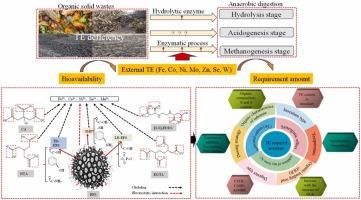微量元素对有机固体废物厌氧消化影响的综合评述
IF 6.9
2区 环境科学与生态学
Q1 ENGINEERING, CHEMICAL
引用次数: 0
摘要
内在微量元素(TE)的缺乏限制了有机固体废物(OSW)厌氧消化系统的性能和产品产量。为了确保酶的合成,促进厌氧微生物的生长和新陈代谢,必须补充外部微量元素。系统中 TE 的含量对颗粒基质的水解效率、水解和酸化水平以及产酸菌的生长都有一定的影响。由于 TE 在金属酶的合成和甲烷菌代谢的调节中起着举足轻重的作用,因此 TE 的浓度对甲烷生成的阶段有显著的正向或负向影响。以一些有机成分、氮和硫含量不同的特殊底物为例,评估了 TE 对甲烷产量、消化性能、系统稳定性和甲烷菌生态功能的综合影响。消化基质的有机物特性、接种物类型、温度、有机物负载率、消化器类型、配料策略和协同效应等方面的差异是导致所有有机挥发性有机物消化系统需要定制 TE 配料要求的重要因素。考虑到基质特征和各种操作参数,对 TE 需求量和剂量的估算方法进行了全面审查。此外,毒性当量的生物利用率主要受其生物可利用化学规格的影响。合成螯合剂,如柠檬酸(CA)、乙二胺四乙酸(EDTA)、硝基三乙酸(NTA)和乙二胺-N,N-二丁二酸([S,S]-EDDS),已被广泛证明能有效地与配体相互作用,从而提高 TE 的生物利用率,进而减少消化过程中 TE 的用量。然而,合成螯合剂的不可生物降解性和持久性,以及潜在的致癌性,往往限制了它们在环境中的应用。令人担忧的是,天然微生物分泌物,如可溶性代谢产物(SMPs)和胞外多糖物质(EPS),包含多种功能基团、负电荷和众多结合位点,通过螯合和吸附作用与 TE 发生络合反应,从而提高 TE 的生物利用率。本文章由计算机程序翻译,如有差异,请以英文原文为准。

A comprehensive review of the impact of trace elements on anaerobic digestion for organic solid wastes
The deficiency of inherent trace elements (TE) limits the performance and product yields in anaerobic digestion systems for organic solid wastes (OSW). External TE supplementation is necessary to ensure the synthesis of enzymes and promote the growth and metabolism of anaerobic microorganisms. TE content of the system has exerted a certain influence on the hydrolysis efficiency of particle substrate, as well as the level of hydrolysis and acidification, and the growth of acidogenic bacteria. Due to the pivotal role of TE in the synthesis of metalloenzymes and regulation of methanogen metabolism, TE concentration exerts a significant positive or negative impact on the stage of methanogenesis. Comprehensive effects of TE on the methane yields, digestion performance, system stability, and ecological functions of methanogens were evaluated using some specialized substrates with different type of organic composition, nitrogen and sulfur contents as illustrative examples. The variation in organic characteristics of digestion substrate, inoculum type, temperature, organic loading rate, digester type, dosing strategies and synergistic effect are significant factors that contribute to the need for tailored TE dosing requirements in all OSW digestion systems. The estimation methods for TE requirements and dosages, considering substrate characteristics and various operational parameters, have been comprehensively reviewed. Additionally, the bioavailability of TE is mainly influenced by their bioavailable chemical speciation. Synthetic chelating agent such as citric acid (CA), ethylenediaminetetraacetic acid (EDTA), nitrilotriacetic acid (NTA) and ethylenediamine-N, N-disuccinic acid ([S,S]-EDDS), have been extensively demonstrated to effectively interact with ligands, thereby enhancing the bioavailability of TE and subsequently reducing the dosage of TE in the digestion process. However, the non-biodegradable and persistent nature of synthetic chelating agents, coupled with their potential carcinogenicity, often limits their application in the environment. It's worthing that the natural microbial secretion, such as soluble metabolic products (SMPs) and extracellular polysaccharides substances (EPS), which encompass a variety of functional groups, negative charge, and numerous binding sites, demonstrate significant potential in complexing with TE through chelation and adsorption effects, thereby enhancing the bioavailability of TE.
求助全文
通过发布文献求助,成功后即可免费获取论文全文。
去求助
来源期刊

Process Safety and Environmental Protection
环境科学-工程:化工
CiteScore
11.40
自引率
15.40%
发文量
929
审稿时长
8.0 months
期刊介绍:
The Process Safety and Environmental Protection (PSEP) journal is a leading international publication that focuses on the publication of high-quality, original research papers in the field of engineering, specifically those related to the safety of industrial processes and environmental protection. The journal encourages submissions that present new developments in safety and environmental aspects, particularly those that show how research findings can be applied in process engineering design and practice.
PSEP is particularly interested in research that brings fresh perspectives to established engineering principles, identifies unsolved problems, or suggests directions for future research. The journal also values contributions that push the boundaries of traditional engineering and welcomes multidisciplinary papers.
PSEP's articles are abstracted and indexed by a range of databases and services, which helps to ensure that the journal's research is accessible and recognized in the academic and professional communities. These databases include ANTE, Chemical Abstracts, Chemical Hazards in Industry, Current Contents, Elsevier Engineering Information database, Pascal Francis, Web of Science, Scopus, Engineering Information Database EnCompass LIT (Elsevier), and INSPEC. This wide coverage facilitates the dissemination of the journal's content to a global audience interested in process safety and environmental engineering.
 求助内容:
求助内容: 应助结果提醒方式:
应助结果提醒方式:


